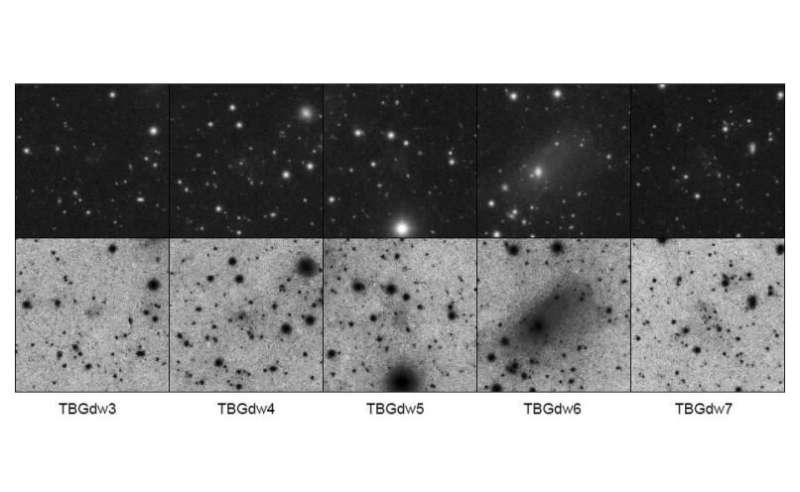Mosaic of direct and inverted images of low surface brightness dwarf galaxies in the vicinity of M 63. Credit: Karachentsev et al., 2020.
Using an amateur 0.14-m aperture telescope, astronomers have observed a nearby spiral galaxy known as M63 (or NGC 5055). The observations identified the presence of five faint dwarf galaxies around M63 and allowed the researchers to determine their basic parameters. The finding is reported in a paper published November 10 on arXiv.org.
Dwarf galaxies, containing up to several billion stars, are difficult to detect due to their low luminosity, low mass and small size. Astronomers usually find them as companions to larger galaxies. It is assumed that large galaxies observed today formed either by collisions of dwarf galaxies or by larger galaxies attracting material away from these dwarfs.
At a distance of some 29.3 million light years, M63, dubbed the "Sunflower Galaxy" is a large spiral galaxy with no central bar feature and moderate to loosely wound arms. Previous observations of M63 have uncovered the presence of multiple arches and "plumes" of low surface brightness on its periphery. This very faint system of streams is assumed to be a result of accretion of a dwarf satellite in the last few billion years.
To date, several dwarf galaxies have been detected in the neighborhood of M63 that may be satellites of this galaxy. Now, a team of astronomers led by Igor Karachentsev of the Special Astrophysical Observatory (SAO) in Russia have added more objects to this list. By inspecting an image obtained with the 0.14-m aperture refractor TEC140ED APO at f/7 focal ratio using a Moravian G3-16200 Monochrom CCD (KAF-16200) camera, they found five new candidates for M63 satellites of very low surface brightness.
"We present a deep (50 hours exposed) image of the nearby spiral galaxy M63 (NGC 5055), taken with a 0.14-m aperture telescope. (...) We found five very low-surface-brightness dwarf galaxies around M63," the astronomers wrote in the paper.
The newly found dwarf galaxies received designations TBGdw3 to TBGdw7. The median absolute B-magnitude of these galaxies is –8.8 mag and they have median surface brightness of about 27.8 mag/sq. arcsec.
The largest two objects are TBGdw7 and TBGdw3, with maximum angular diameter of approximately 21.7 and 21.6 arcmin. The smallest one is TBGdw6, as it has a maximum angular diameter of some 18.5 arcmin. The astronomers added that the dwarf galaxy status of TBGdw6 needs further confirmation as there is a possibility that it may be a patch of reflecting nebulae.
TBGdw5 is the nearest dwarf to M63, with a linear projected separation of about 283,600 light years from this galaxy. The most distant from M63 was found to be TBGdw4 - the separation is approximately 394,500 light years.
Moreover, the orbital mass of the M63 halo was estimated to be about 510 billion solar masses. It was also found that M63 has a low ratio of the total mass-to-stellar luminosity as it was calculated to be approximately 4.8. This value is about six times lower than the respective ratio for our Milky Way galaxy and M 31.
More information: Karachentsev et al., New dwarfs around the curly spiral galaxy M63, arXiv:2011.04984 [astro-ph.GA] arxiv.org/abs/2011.04984
© 2020 Science X Network
























